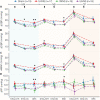Transcutaneous auricular Vagus Nerve Stimulation and Median Nerve Stimulation reduce acute stress in young healthy adults: a single-blind sham-controlled crossover study
- PMID: 37746156
- PMCID: PMC10512834
- DOI: 10.3389/fnins.2023.1213982
Transcutaneous auricular Vagus Nerve Stimulation and Median Nerve Stimulation reduce acute stress in young healthy adults: a single-blind sham-controlled crossover study
Abstract
Stress is a major determinant of health and wellbeing. Conventional stress management approaches do not account for the daily-living acute changes in stress that affect quality of life. The combination of physiological monitoring and non-invasive Peripheral Nerve Stimulation (PNS) represents a promising technological approach to quantify stress-induced physiological manifestations and reduce stress during everyday life. This study aimed to evaluate the effectiveness of three well-established transcutaneous PNS modalities in reducing physiological manifestations of stress compared to a sham: auricular and cervical Vagus Nerve Stimulation (taVNS and tcVNS), and Median Nerve Stimulation (tMNS). Using a single-blind sham-controlled crossover study with four visits, we compared the stress mitigation effectiveness of taVNS, tcVNS, and tMNS, quantified through physiological markers derived from five physiological signals peripherally measured on 19 young healthy volunteers. Participants underwent three acute mental and physiological stressors while receiving stimulation. Blinding effectiveness was assessed via subjective survey. taVNS and tMNS relative to sham resulted in significant changes that suggest a reduction in sympathetic outflow following the acute stressors: Left Ventricular Ejection Time Index (LVETI) shortening (tMNS: p = 0.007, taVNS: p = 0.015) and Pre-Ejection Period (PEP)-to-LVET ratio (PEP/LVET) increase (tMNS: p = 0.044, taVNS: p = 0.029). tMNS relative to sham also reduced Pulse Pressure (PP; p = 0.032) and tonic EDA activity (tonicMean; p = 0.025). The nonsignificant blinding survey results suggest these effects were not influenced by placebo. taVNS and tMNS effectively reduced stress-induced sympathetic arousal in wearable-compatible physiological signals, motivating their future use in novel personalized stress therapies to improve quality of life.
Keywords: Median Nerve Stimulation; Vagus Nerve Stimulation; multimodal sensing; non-invasive; physiological signals; stress.
Copyright © 2023 Sanchez-Perez, Gazi, Rahman, Seith, Saks, Sundararaj, Erbrick, Harrison, Nichols, Modak, Chalumuri, Snow, Hahn and Inan.
Conflict of interest statement
The authors declare that the research was conducted in the absence of any commercial or financial relationships that could be construed as a potential conflict of interest.
Figures





Similar articles
-
Ear your heart: transcutaneous auricular vagus nerve stimulation on heart rate variability in healthy young participants.PeerJ. 2022 Nov 21;10:e14447. doi: 10.7717/peerj.14447. eCollection 2022. PeerJ. 2022. PMID: 36438582 Free PMC article.
-
Quantifying acute physiological biomarkers of transcutaneous cervical vagal nerve stimulation in the context of psychological stress.Brain Stimul. 2020 Jan-Feb;13(1):47-59. doi: 10.1016/j.brs.2019.08.002. Epub 2019 Aug 6. Brain Stimul. 2020. PMID: 31439323 Free PMC article. Clinical Trial.
-
Technical Note: Modulation of fMRI brainstem responses by transcutaneous vagus nerve stimulation.Neuroimage. 2021 Dec 1;244:118566. doi: 10.1016/j.neuroimage.2021.118566. Epub 2021 Sep 10. Neuroimage. 2021. PMID: 34509623
-
Does transcutaneous auricular vagus nerve stimulation affect vagally mediated heart rate variability? A living and interactive Bayesian meta-analysis.Psychophysiology. 2021 Nov;58(11):e13933. doi: 10.1111/psyp.13933. Epub 2021 Sep 2. Psychophysiology. 2021. PMID: 34473846 Review.
-
Transcutaneous Auricular Vagus Nerve Stimulation Combined With Slow Breathing: Speculations on Potential Applications and Technical Considerations.Neuromodulation. 2022 Apr;25(3):380-394. doi: 10.1111/ner.13458. Epub 2021 Jun 23. Neuromodulation. 2022. PMID: 35396070 Review.
Cited by
-
Neuromodulation in the intensive care unit.Intensive Care Med. 2024 Sep;50(9):1523-1525. doi: 10.1007/s00134-024-07561-x. Epub 2024 Jul 24. Intensive Care Med. 2024. PMID: 39046487 Free PMC article. No abstract available.
-
Effects of taVNS on physiological responses and cognitive performance during a mental stressor.Cogn Affect Behav Neurosci. 2025 Sep 4. doi: 10.3758/s13415-025-01341-w. Online ahead of print. Cogn Affect Behav Neurosci. 2025. PMID: 40908377
-
Accrued reductions in heart rate following transcutaneous vagal nerve stimulation in adults with posttraumatic stress disorder.Front Neurosci. 2025 Mar 28;19:1456662. doi: 10.3389/fnins.2025.1456662. eCollection 2025. Front Neurosci. 2025. PMID: 40224646 Free PMC article.
-
Non-Pharmacological Mitigation of Acute Mental Stress-Induced Sympathetic Arousal: Comparison Between Median Nerve Stimulation and Auricular Vagus Nerve Stimulation.Sensors (Basel). 2025 Feb 23;25(5):1371. doi: 10.3390/s25051371. Sensors (Basel). 2025. PMID: 40096118 Free PMC article.
-
Transcutaneous Auricular Vagus Nerve Stimulation to Improve Emotional State.Biomedicines. 2024 Feb 9;12(2):407. doi: 10.3390/biomedicines12020407. Biomedicines. 2024. PMID: 38398009 Free PMC article. Review.
References
-
- Atterhög J. H., Eliasson K., Hjemdahl P. (1981). Sympathoadrenal and cardiovascular responses to mental stress, isometric handgrip, and cold pressor test in asymptomatic young men with primary T wave abnormalities in the electrocardiogram. Br. Heart J. 46, 311–319. 10.1136/hrt.46.3.311 - DOI - PMC - PubMed
-
- Badran B. W., Brown J. C., Dowdle L. T., Mithoefer O. J., LaBate N. T., Coatsworth J., et al. . (2018a). Tragus or cymba conchae? Investigating the anatomical foundation of transcutaneous auricular vagus nerve stimulation (taVNS). Brain Stimul. 11, 947–948. 10.1016/j.brs.2018.06.003 - DOI - PMC - PubMed
-
- Badran B. W., Dowdle L. T., Mithoefer O. J., LaBate N. T., Coatsworth J., Brown J. C., et al. . (2018b). Neurophysiologic effects of transcutaneous auricular vagus nerve stimulation (taVNS) via electrical stimulation of the tragus: a concurrent taVNS/fMRI study and review. Brain Stimul. 11, 492–500. 10.1016/j.brs.2017.12.009 - DOI - PMC - PubMed
LinkOut - more resources
Full Text Sources
Miscellaneous

